Article
Sailing the River Rhine Part 2: Crossing Time and Borders in Alsace, France
Author(s):
Alsace sits on the edge of France near Germany, and its history is rich with influences from both countries.

The Uniworld map of our Legendary Rhine & Moselle cruise shows where we have arrived on our third day: Strasbourg. Tomorrow is Germany but our tour of France will end today in Alsace, this land that has swung between French and German sovereignty along the Rhine for about two centuries. A French town, it was annexed by Bismarck in 1871 when Germany defeated France at the end of the Franco-Prussian war (a war that France had started the previous year). Thereafter, neither tourists nor citizens knew which country they were in. Alsace is thus interesting; it has characteristics of both countries.
There’s a Roman presence as well. After the town was rebuilt in the 6th century (from its destruction by Attila) it was given the Latin name “Strate burgum” — literally town of the roads. Its history is less accentuated now that Strasbourg is one of the “instruments” of the European Union, the others being Brussels and Luxemburg, and sometimes Frankfurt. We won’t get into the EU story because it’s told with some asperity by some European guides who appear to resent the favoritism the EU has seemingly given its “capitals.”
As we board the Strasbourg by Canal cruise arranged by Uniworld and head into the “European Quarter,” where all the pan-European institutions are housed, we can hear the pride in the local guide’s voice when she talks about Strasbourg. That said, we feel American visitors would probably prefer to hear about the history of Strasbourg rather than its status in the EU, given how confusing its politics are.
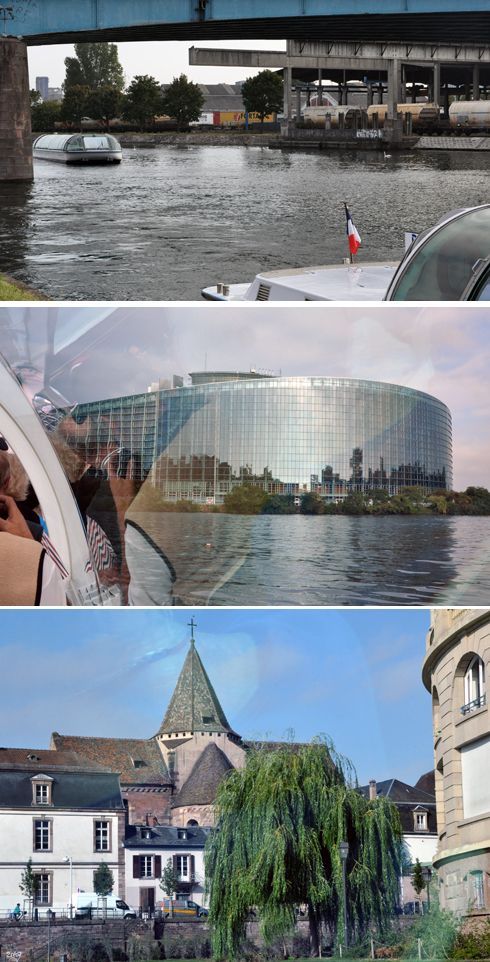
The canal cruise is delightful. It is not always clear whether we are on the canal network of the town or on the River Ill itself, one of the tributaries of the Rhine. Does it matter? We are seeing the heart of Strasbourg.
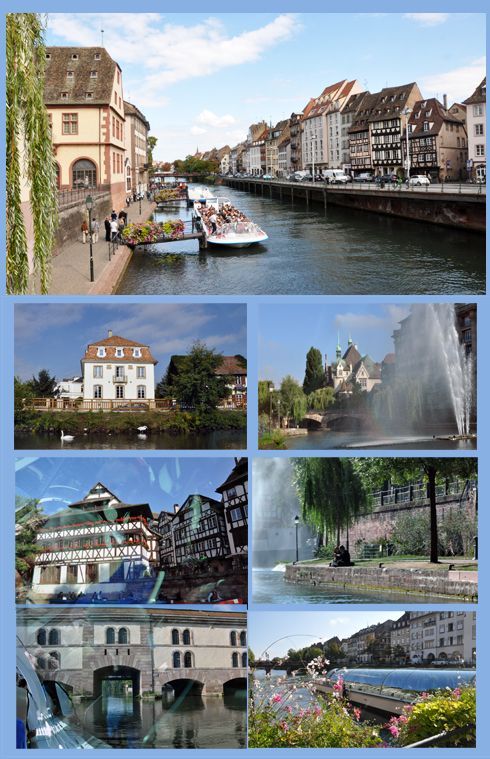
We have given up trying to decide whether the medieval architecture we see from the canal is French or German. It is too similar. This is a land marked by its geography not national politics.
Once the canal cruise is over we take a walking tour of Strasbourg through the German Quarter past most of the interesting places in town. There is also free time in town for which visitors might want to search for one of the many GPS walking maps available, some like GPSMYCITY are available for smartphones iPhone or Android which work offline too.
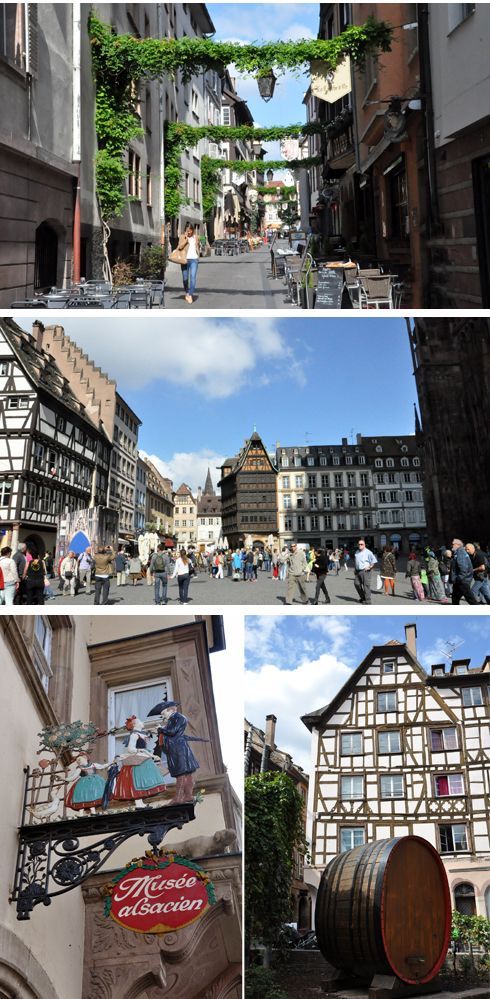
Everyone in town seems to be walking. You may as well join them. A sign brings you to the 1907 Musee Alsacien that shows what life was like in Strasbourg many years ago. The barrel was donated in 2000 by the winemakers of the Couronne d’Or vineyards of Strasbourg who also planted the vines on the left of the bottom right image.
It’s short walk to the Place Gutenberg named after Johannes Gensfleisch Gutenberg, the printer who was born in Mainz in Germany, 125 miles to the North farther up the Rhine. Our article on him and on German wine can be seen here. The statues in the two towns were erected within three years by local sculptors, here by David d’Angers in 1840. Both statues show Gutenberg with a long beard but no one knows if he indeed was bearded. The four bas reliefs show the impact of printing on world events. The one we enlarged, Detail of America, shows Benjamin Franklin and other signatories to the Declaration of Independence and “other famous liberators like General Lafayette and Simon Bolivar,” and how printing allowed the American message to cross the world quickly. The houses around the square have the steep sloping roofs typical of Alsace “where winter snow is a way of life.”
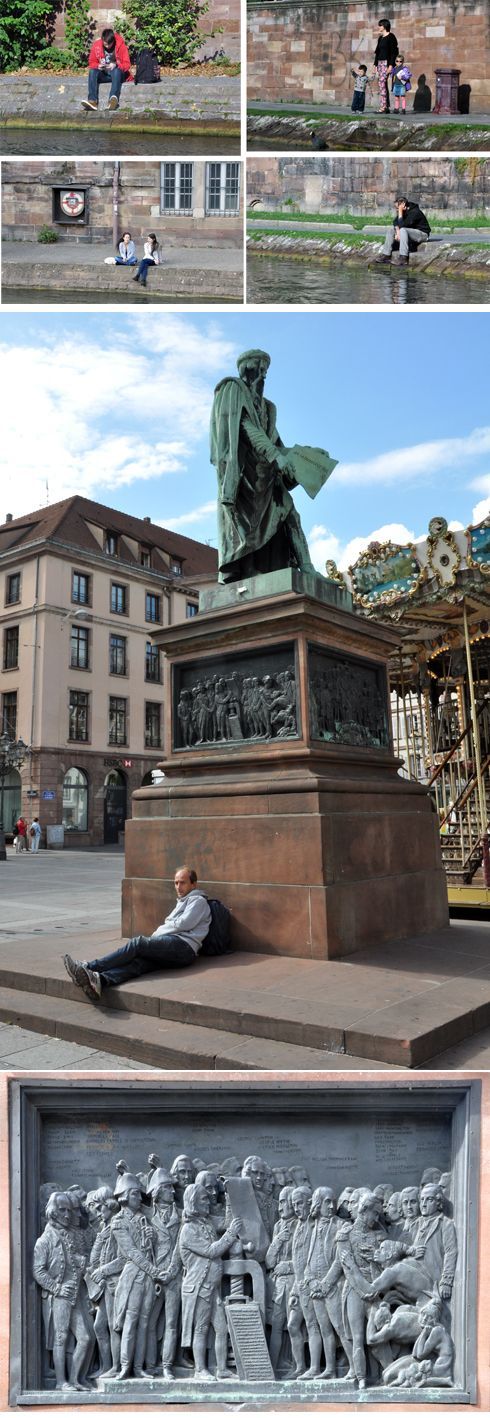
Place Gutenberg
Your walk will ultimately follow the crowd and take you to the Cathedral, at one time the highest building in the world. It still attracts 4 million visitors a year. It is famous for its beautifully decorated organ pipes and pulpit, and for its stained glass round window which rivals that of Chartres. It is celebrated also for its astronomical clocks the first of which was created in 1352 and the last in1842.
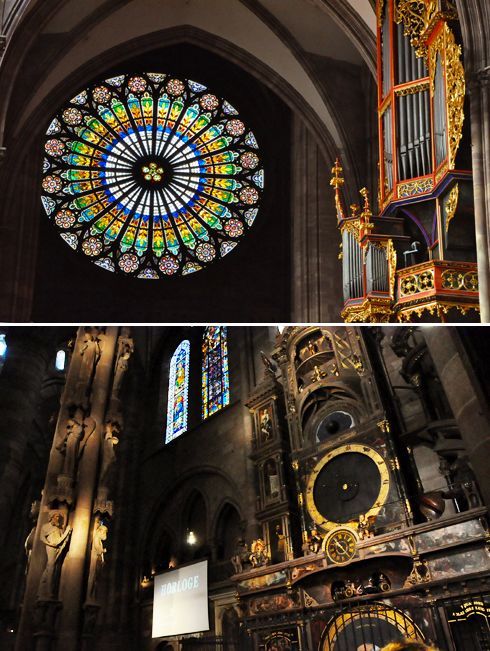
The Cathedral was built over a period of 4 centuries (1015-1439).
There are so many museums in Strasbourg that TripAdvisor offers information on its Top Ten of the city’s 17. Try and include a visit to the Strasbourg History Museum which is free and much larger than it looks.
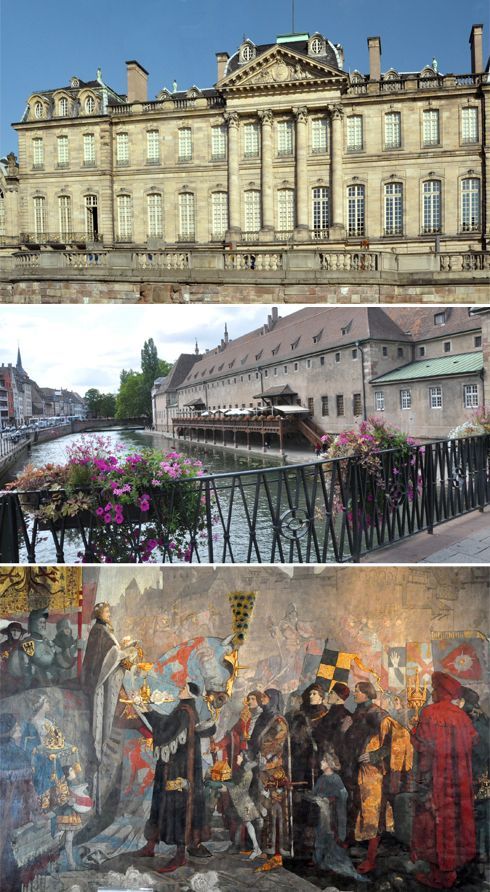
Top.Museums: Museum of Fine Arts. Museum of Modern and Contemporary Art. Lower image is part of a large painting of the Formal Entrance of the Emperor Sigismond in Strasbourg in 1414 by Leo Schnug, an artist born near Strasbourg in 1878 who specialized in massive historical events until his “documented alcoholic dementia” put his artistic skills in decline. Author image published courtesy of Strasbourg History Museum. Physicians wishing to know more about Schnug’s neurological illness click here.
Today goodbye France, tomorrow Hello Germany.
To view and share these photos on Facebook, click on our gallery below:
Photos from Eric and Nancy Anderson's latest travel column. To read the story, click here:...
Posted by PhysiciansMoneyDigest on Tuesday, March 8, 2016
Photography by the authors.
The Andersons, who live in San Diego, are the resident travel & cruise columnists for Physician's Money Digest. Nancy is a former nursing educator, Eric a retired MD. The one-time president of the New Hampshire Academy of Family Physicians, Eric is the only physician in the Society of American Travel Writers. He has also written five books, the last called The Man Who Cried Orange: Stories from a Doctor's Life.




